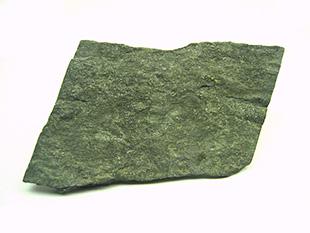












The result is a foliated rock in which the foliation may not correspond to the original sedimentary layering.
Chemical composition
Slate is mainly composed of quartz and muscovite or illite, often along with biotite, chlorite, hematite, and pyrite along with, less frequently, apatite, graphite, kaolin, magnetite, tourmaline, or zircon as well as feldspar. Occasionally, as in the purple slates of North Wales, ferrous reduction spheres form around iron nuclei, leaving a light green spotted texture. These spheres are sometimes deformed by a subsequent applied stress field to ovoids, which appear as ellipses when viewed on a cleavage plane of the specimen.
Slate can be made into roofing slates, also called roofing shingles, installed by a slater. Slate has two lines of breakability: cleavage and grain. This makes it possible to split slate into thin sheets. Fine slate can also be used as a whetstone to hone knives. Due to its thermal stability and chemical inertness, slate has been used for laboratory bench tops and for billiard table tops. In 18th and 19th century schools, slate was extensively used for blackboards and individual writing slates for which chalk pencils were used. Because it was a good electrical insulator and was fireproof, it was used to construct early 20th century electric switchboards and relay controls for large electric motors. Stephen Kettle is notable as a British sculptor for his use of slate to create statues housed in the Science Museum in London.
Slate tiles are often used for interior and exterior flooring or wall cladding. Tiles are installed and set on mortar and grouted along the edges. Chemical sealants are often used on tiles to improve durability and appearance, increase stain resistance, reduce efflorescence, and increase or reduce surface smoothness. Tiles are often sold gauged, meaning that the back surface is ground for ease of installation.
Slate is often used as a decor in freshwater aquariums. Slate will not alter the chemistry of water (except in the slate containing felspar which may leech silicates into the water resulting in excess diatom growth in marine aquaria). When broken, slate produces a natural appearance while remaining relatively flat and can be easily stacked. Silicon glue adheres to slate, creating a non-toxic bond to secure it. It is also used in stairs and pathways for the same reasons.
By Appointment
PARIS CERAMICS
South Park Studios - Suite 10
88 Peterborough Road, London SW6 3HH
United Kingdom